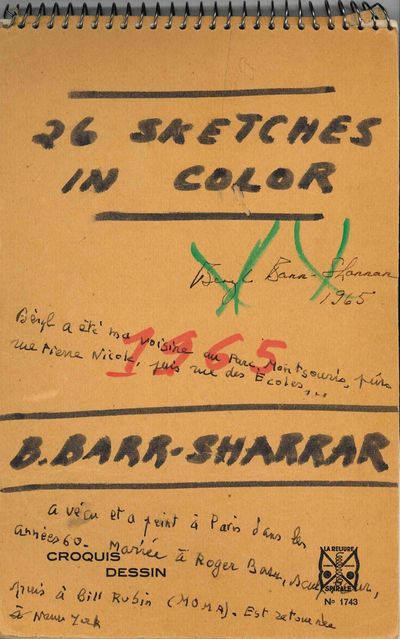
Barr-Sharrar, Beryl & Pierre Lecuire
26 Sketches in Color
- $2,750
A remarkable sketchbook with 25 original gouache paintings (there is no work number 14) by Beryl Barr-Sharrar, for Pierre Lecuire. Small oblong octavo (8 1/8 x 5 1/4 inches). Cardboard covers, metal spiral binding. Some light bumping to edges, paintings in beautiful and bright condition, overall excellent. N.p. (Paris), 1968. This beautiful notebook is inscribed inside the front cover, "Pour Pierre de Beryl, 20 Août, 1968, ces 25 esquisses en couleurs". The title is hand-written on the front cover, and a date of 1965 given under Barr-Sharrar's name. There is also a hand-written note from Lecuire, which mentions that Béryl was his neighbor in Paris in the 1960's and was married first to sculptor Roger Barr and then to Bill Rubin of the Museum of Modern Art, and has since returned to New York.
Beryl Barr-Sharrar (b. 1935) is an American artist who studied the American Abstract Expressionists in Berkeley and New York before moving to Paris in the 1960's and beginning her career as a professional artist. In 1962 she co-founded the College Art Study Abroad program, and served as its director until she returned to the United States in 1968. She taught painting and printmaking at Mount Holyoke, and in 1970 began studying classical archaeology at the IFA at New York University. She continued to paint and exhibit her work for several years but after 1980, focused primarily on her academic career. A handful of years ago, she returned to exhibiting her work as a painter with a three-person show in Long Island City, in 2016.
Her work was exhibited at the Lucian Durand Gallery in 1967, and of her paintings it was said, "Beryl Barr-Sharrar's work has the vigor and know-how of American action painting at its best, and the refinement of color of the School of Paris. The result is both captivating and awe-inspiring."
Pierre Lecuire (1922-2013) was a French poet and publisher who collaborated closely with numerous artists to design and publish beautifully crafted books. It is unclear how exactly Lecuire and Barr-Sharrar crossed paths, but perhaps he became aware of her work during those exhibitions in Paris in the late 1960s.
The 25 small paintings in this sketchbook showcase Barr-Sharrar's study of Abstract Expressionism and her bold use of color. A beautiful and unique volume of original art.
More from F.A. Bernett Books
![Graficheskie kompozitsii [Graphic compositions]](https://rarebookinsider.com/wp-content/uploads/2024/05/1603772582.0.l.jpg)
Graficheskie kompozitsii [Graphic compositions]
Vekstein, Leonid Small volume of movement study drawings in a Constructivist and Cubist-influenced style. Oblong octavo (6 3/4 x 10 3/8 inches). Original printed wrappers. Light browning, minor soiling to covers, small areas of wear and loss along edges and spine, some staining near staples, light scattered spotting to interior, overall very good. Leningrad: n.p., 1929. Little is known about the artist who created these images. However, there is a three-page introduction that precedes the 48 figure studies titled "Synthesis of Form, Dynamics of Action, Rhythm of Lines", in which Vekstein discusses the sense of movement he instilled into some of his drawings. He mentions the curves of the figures of laundresses echoing the curves of the iron and the fabric, or the swing of the shovel, scythe, or hammer by a worker. Other rounded lines evoke music, speed, or vibration. The studies are clearly taking inspiration from Constructivist and Cubist art in their style and interpretation. A fascinating sketchbook; as of April 2024, we could find no records of this work on OCLC.- $600
- $600
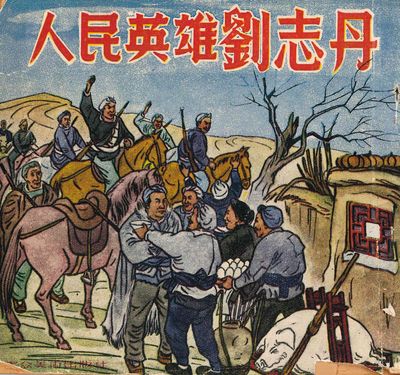
Ying Ying de Zao Yu (Ying Ting’s Misfortune)
Keyang, Yang Small Chinese comic-book style booklet. Square 16mo (4 3/4 x 5 1/4 inches). Original pictorial wrappers; 4, 96 pp. Light wear to corners; some toning to leaves; a few losses to corners of last few leaves (pp. 81-96), with no loss to images; paper brittle; overall good. Shanghai (Da zhong mei shu chu ban she/The Masses Artistic Publishing Company) 1949. Small Chinese propaganda booklet in "lianhuanhua" or comic book format, telling the political morality story of Ying Ying, the heroine who grew up in "suffering and depravation" but finds new life in the People's Liberation, with bold black-and-white woodcut illustrations by Keyang to every page. Yang Keyand (1914-2010) studied wood engraving with various masters, and in the 1940's participated in anti-Japanese activities and joined the All-China Wood Engraving Association Movement. During the Creative Print Movement in 1930s China, the woodblock and its ease of mass-production of images was repurposed to serve new political purposes. Many artists created prints with clear nationalistic messages, while others made images of political protest. The outbreak of the Sino-Japanese War in 1937 united these two themes in the work of many artists. Very scarce; as of April 2024, WorldCat locates only two holdings in North America.- $950
- $950
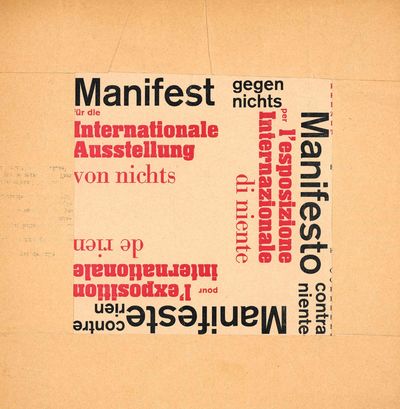
Manifest gegen Nichts ur die Internationale Ausstellung von Nichts. Manifesto contra Niente per L’Esposizione Internationale di Niente. Manifeste contre Rien pour l’Exposition Internationale de Rien
Hamburg.- Galerie Grundweg A single page broadsheet for an exhibition printed in red and black on cream-colored paper stock with typography in various font sizes by Onorio, and the text in each language oriented in a different direction on the page. 11 5/8 inches by 11 7/8 inches, folded to 8 1/2 by 8 1/2 inches. Loose as issued. Creasing, light browning to paper, overall very good. Hamburg/Basel, 1960. This broadsheet was published in conjunction with an "exhibition of nothing" organized by members of the Zero group, Fluxus members, and others. It consisted of an empty gallery with nothing for sale. The text on the broadsheet indicates that a price list of essentially nothing is available, and no one will be speaking at the opening of the exhibition. "Verkauft wird nichts, numeriert und signiert. Preisliste liegt aus. Zur Eröffnung spricht niemand." Participants included Carl Laszlo, Onorio, Rolf Fenkart, Bazon Brock, Herbert Schuldt, Piero Manzoni, Enrico Castellani, Heinz Mack, and Otto Piene. The exhibition caused a stir and was well-attended. In fact, the exhibition was held over to accomodate the large number of visitors. The manifesto states that the exhibition promotes Avantgardism, Conventionalism, Modernism, Conservatism, Communism, Capitalism, Patrioism, Internationalism, Monochromism, Monotonism, Zen, Surrealism, Dadasim, Lettrisme, Constructivism, Neoplasiticism, and Tachisme. As of February 2024, OCLC locates only two holdings in North America of this fascinating and notable document in the history of 20th century art.- $1,500
- $1,500
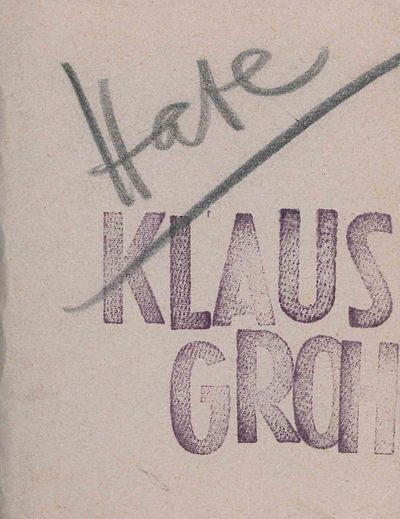
Two Miniature Artist’s Books: Love. Hate
Groh, Klaus Two small unpaginated artist's books, signed and dated by Groh. Each booklet 3 7/8 x 2 3/4 inches. Side-stapled gray cardstock, titles handwritten in pencil to front covers and Groh's name rubber-stamped, hand-signed and dated '87 in pencil to back covers. Extremely light soiling to covers, overall excellent. N.p, 1987. Klaus Groh (b. 1936) is a German artist and author who helped bring Mail Art from America to Europe and established an international Mail Art network. He directed the Micro Hall Art Center and the cabaret Literaturium as well as the International Artists' Cooperation (I.A.C.), the latter of which he ran from 1969 to 1990. These two miniature artist's books, titled "Love" and "Hate", are comprised of cut-up pages from a German telephone book, including some personal names and phone numbers as well as advertisements for businesses. They are unpaginated, each comprised of approximately 48 double-sided leaves. These two volumes are possibly unique; as of April 2024, there were no listings for either booklet on OCLC.- $650
- $650

Architetture Luminose e Apparecchi per Illuminazione
Canesi, Giovanni, & Antonio Cassi Ramelli (3), 162 pp. survey of the use of artificial lighting in modern architecture, profusely illustrated. Quarto (11 x 9 inches). Cloth boards with stamped title to cover. Light soiling and minor handling wear, overall very good. Milan (Ulrico Hoepli) 1934. Profusely illustrated survey of Art Deco and modernist lighting fixtures and both interior and exterior settings for lighting designed by 100 international architects, including Robert Mallet Stevens, Achille Donzelli, Mario Faravelli, Rudolf Fränkel, René Herbst, Erich Mendelsohn, André Salomon, Carlo Enrico Rava, Hans Poelzing, Aldo Viale, Alberto Strozzi, Paulo Buffa, Piero Bottoni, Edgar Brandt, Joseph Urban, and many others. The majority of the illustrations are from photographs, but some also show plans or elevations and other details. There are 216 illustrations total, including 128 of architecture and 88 of fixtures, most in public spaces and in buildings in which lighting is a key feature.- $500
- $500
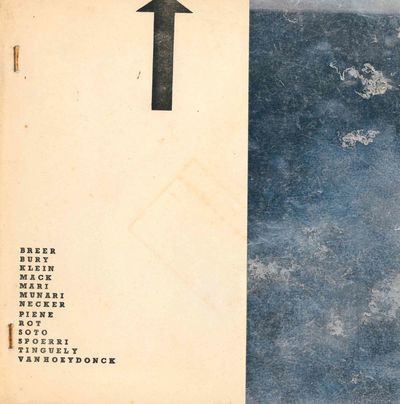
Motion in Vision/Vision in Motion
Unpaginated (26 pp.) catalogue published on the occasion of the landmark exhibition at the Hessenhuis in Antwerp, held from March 21 to May 3, 1959. Square octavo (8 1/4 x 8 1/4 inches). Original side-stapled wrappers. Light rubbing to aluminum leaf, slight rust-staining around staples, scattered foxing, back cover loose, overall very good. Antwerp: Hessenhuis, 1959. The ZERO group was founded in Düsseldorf by Otto Piene and Heinz Mack. Their aim, Piene once wrote, was to create "a zone of silence and of pure possibilites for a new beginning." In contrast to the popular Abstract Expressionist movement, ZERO artists championed kinetic and light elements such as chrome, aluminum, latex, and motors. Contemporaneous groups existed in other parts of Europe and Asia, as well as the Americas, including the Nul group in the Netherlands, the Nouveaux Réalistes in France, Azimuth in Italy, and the Gutai group in Japan. According to an article on the group, "No longer certain that painting best represented the modern age, Piene, Mack, and Uecker developed a new visual language based on science and a poetic existentialism. Many of the works that emerged used light, colour and movement rather than solid materials to convey the visionary potential of science, while also reflecting Cold War anxieties. As the artists' friend and champion Yves Klein wrote, 'We are living in the atomic age, where everything material and physical could disappear from one day to another, to be replace by nothing but the ultimate abstraction imaginable.'" (Heroes of Zero: the art collective that inspired a generation, Christies.com, 2022) In 1959, the ZERO group held their first exhibition which introduced them to the international public. This catalogue was published in conjunction with that exhibition. The exhibition was artist-curated, and included the participation of Robert Breer, Pol Bury, Yves Klein, Heinz Mack, Enzo Mari, Bruno Munari, Günther Uecker (spelled "Necker" on the cover), Otto Piene, Diter Rot, Jesús Rafael Soto, Daniel Spoerri, Jean Tinguely, and Paul Van Hoeydonck. Contributors to the catalogue, which was edited by Marc Callewaert, included Emmet Williams, Heinz Mack, Otto Piene, Pol Bury, Dieter Rot, Jean Tinguely, and Paul Van Hoeydonck. These include paper cuttings, a silver aluminum leaf, tipped-in illustrations, and a letterpress page. Very scarce; as of February 2024, OCLC only locates two holdings of this important catalogue in North America.- $2,500
- $2,500
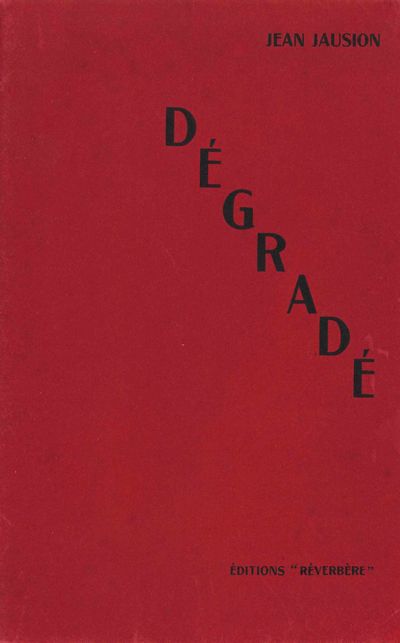
Dégradé. Suivi de Théâtre des marionnettes, avec une composition de Jean Marembert
Jausion, Jean Paris: Éditions Réverberes, 1928. Octavo (21 ×13.5 cm). Original printed wrappers; unpaginated (33 pp.) including a frontispiece after a drawing by Jean Marembert. Overall very good condition. Limited edition of 300 copies. Rare volume of poems published by the neo-Dadaist group Les Réverbères, which was founded in December 1937 by Michel Tapié, Jean Marembert, Jacques Office, Pierre Minne, and Henri Bernard, and which promoted Dadaist exhibitions, jazz concerts, stage performances, and published literary works. Among the exhibitors were: Louis Cattiaux, Marembert, Pierre Minne, Tapié, as well as members of the "La Main à plume" surrealist group: Noël Arnaud, Marc Patin, Jean-François Chabrun, and others. Among other events, the group also organized "Tribute to Dada" soirées, which featured readings of texts by Tristan Tzara, Ribemont-Dessaignes, and others. In "Art of the Defeat: France 1940-1944," Laurence Bertrand Dorléac asserts that the group still met for several gatherings retaining the spirit of the 1930s even after the German occupation of France in June 1940. The Neo-Dadaist activities around Michel Tapié have not been explored to any significant degree and are rarely mentioned in passing in the literature on Dada and Surrealism. One exception is Michel Fauré's book "Histoire du surréalisme sous l'Occupation", published in 1982. The reason for the sparse state of research is probably that the experimental, elaborate avant-garde prints, most of which were produced in very small editions, are hardly accessible due to their rarity. Very scarce; as of December 2023, OCLC lists only 2 copies in North America.- $750
- $750
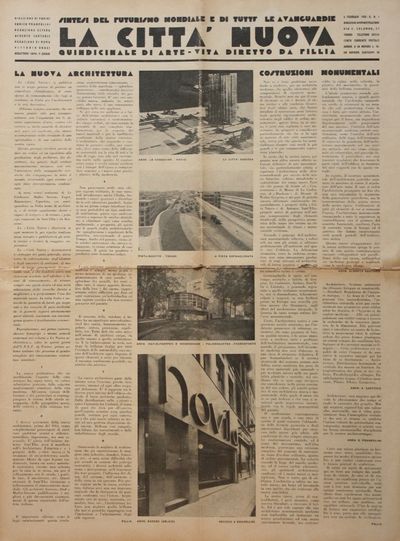
La Città Nuova. Quindicinale di Arte-Vita Diretto da Fillia (Later subtitles: Quindicinale di Architettura and Quindicinale di Architettura e Arte)
Torino, 1932-1934. Tabloid/folio (approx. 56 x 41.5 cm). Original self-wrappers; each issue 8 pp. Some browning to paper, toning, light scattered foxing, some issues with tears along fold lines, overall good condition. Twelve issues in eleven fascicules (Year I, Nos. 1 and 3-6; Year III, Nos. 3-9) of the important Italian Futurist architecture journal, under the direction of Fillia, a leader in the Futurist movement, with editorial assistance and contributions from other noted Futurist artists and figures including Alberto Sartoris, Enrico Prampolini, Nicolay Diulgheroff, Gino Levi-Montalcini, Mino Rosso, Gerardo Dottori, Filippo Marinetti, Walter Gropius, Le Corbusier, Bruno Sanzin, Emilio Odorizio, Pippo Oriani, Italo Lorio and many others, covering topics in domestic and international architecture including functional architecture, modern furniture design, aeropainting, Futurist landscape painting, public architecture, contemporary church architecture, African architecture, urbanism and ruralism, kitchen design, iron construction, Fascist architecture, new building construction in Spain, and many others. Illustrated throughout primarily from photographs. Fillia (Luigi Colombo) helped to establish the Futurist movement in 1923, and quickly became the group's leader and its principal theorist. He published a number of journals including Futurismo, Ventrina Futurista, La Città Futurista, Stile Futurista, and La Città Nuova, co-authored the Manifesto of Futurist Cooking with Marinetti, and designed the Futurist Pavilion at the 1928 International Exhibition in Turin. An excellent and scarce example from the height of the Futurist movement; as of October 2023, OCLC locates only four holdings in the United States.- $6,000
- $6,000
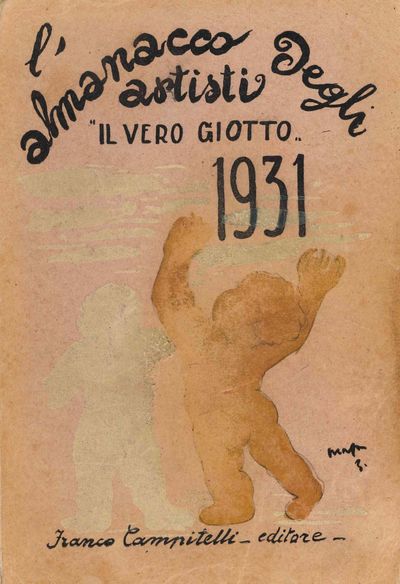
L’Almanacco degli artisti “Il Vero Giotto” 1931
Roma/Foligno: Franco Campitelli, 1931. Duodecimo (19.2 x 13.2 cm). Original illustrated wrappers with cover illustration by Mario Mafai; (2), 432, (4) pp. Some signatures coming loose from binding, overall very good. A small Futurist Italian art almanac, conceived of and compiled by Carlo d'Aloisio da Vasto. This volume features a colver illustration by Mario Mafai and writings by Luciano Folgore, Corrado Pavolini, Luigi Bartolini, C. Govoni, Alfredo Casella, G.B. Angioletti, Alberto Sartoris, Massimo Bontempelli, Vincenzo Costantini, Gerardo Dottori, Anton Bragaglia, and others, as well as illustrations by numerous artists including Morandi, De Pisis, Carrà, Casorati, Soffici, Spadini, and A. Martini. Other volumes were published in 1930 and 1932, but as of October 2023, OCLC locates only 2 holdings of the 1931 almanac in North American libraries.- $150
- $150
26 Sketches in Color: https://rarebookinsider.com/rare-books/26-sketches-in-color/